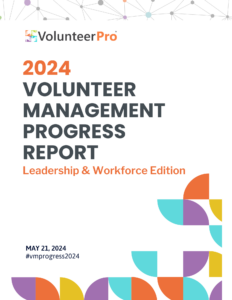 Are You Ready for Today’s Volunteer Needs?
Are You Ready for Today’s Volunteer Needs?
Lately, I’ve heard plenty of volunteer managers complain that there simply aren’t enough people out there volunteering or that the extensive training and commitment required by their program “scares people away.”
Sometimes it seems they’ve given up all hope that volunteerism is still a viable way to deliver service.
That’s a real shame because it’s a major misconception.
There’s plenty of research that shows that community engagement is still alive and kicking.
A change in the way we do business, however, is what will be needed to tap into the vitality of today’s volunteers. Not just lip service — a few new volunteer job descriptions, revamped volunteer training, or a new recognition program — but real, authentic change.
The Litmus Test
If you are someone who’s having second thoughts about volunteerism (or are just plain discouraged about it all) ask yourself: Am I ready to make the changes necessary to welcome today’s volunteers, or do I want to continue with business as usual?
If you stick with the status quo you risk losing even more momentum, and your volunteer corps is likely to keep shrinking. If you change your paradigm, you may very well build a stronger, more passionate volunteer team that gets the job done in ways you never thought possible.
So … in this case, the risk of change isn’t really that risky, is it?
Wonderful, you say. But how do I make the switch?
Consider making the following subtle pivots in the most basic of your volunteer management processes.
7 Pivots to Better Meet Volunteer Needs
- Pivot #1 from Management to Engagement — Instead of a command and control model of supervision and tasks, think about how to motivate community members to work toward your cause. What is their primary motivation?
- Pivot #2 from Recruitment to Cultivation — Start thinking about the cultivation of your volunteers, as you would develop potential donors, versus a “cattle call” for all hands-on deck. Volunteer commitment is a process, not a destination. It takes a full relationship to form if you want to enjoy the full commitment of your partners. This takes time and conversation.
- Pivot #3 from Placement to Negotiation and Agreement — Consider how to best use your volunteer’s skills and talents versus trying to force a square peg in a round hole.
- Pivot #4 from Supervision to Support — Allow for a certain amount of flexibility and independence and build that into your volunteer roles; this doesn’t mean you don’t have expectations, it just means there is any number of ways to get the job done.
- Pivot #5 from Review to Measurement — Instead of conducting annual performance reviews, which everyone hates, focus on the impact the volunteer makes – respected volunteer management expert Jill Friedman Fixler creatively renamed this practice volunteer “valuation” (as opposed to evaluation).
- Pivot #6 from Recognition to Acknowledgement — Volunteers aren’t really looking for another plaque, coffee cup, or paperweight; they want to know that their work has made a difference. Let them know that you understand who they are and the specific value they have brought to the organization and their community.
- Finally, Pivot #7 from Retention to Sustainability — In the past, we were able to rely on volunteers to commit to consistent, unending years of service. This simply isn’t true anymore.
Maintaining sustainability over the long term means that we must rethink how we use volunteer talents, how we reconfigure their work, how we collaborate within our team, and how we share leadership at all levels to ensure the most effective use of the people power we have in the here and now.
Although these at first appear subtle, or merely shifts in semantics, they are anything but.
Use Journey Mapping to Dial into the Needs of Today’s Volunteers

In addition to the pivots above, consider how you might better analyze and understand the needs of your specific volunteer team.
Every volunteer team is different and has needs that are specific to their context. You can borrow from customer service improvement strategies to learn more about the key requirements of your volunteers.
Here’s how you create a volunteer journey map:
- Step One: Choose the type of volunteer group or team you’d like to focus on (do one at a time). For example, you might create journey maps for longer-term volunteers. Anytime the volunteer onboarding and support process is different, a new journey map can be created.
- Step Two: Identify the key points where you interact with potential volunteers before service (outreach and recruitment), during onboarding (application and training), during service (assignments, collaboration, and communication), and post-service (assessment and word of mouth referrals). This can be in person, over the phone, online, or via communications materials.
- Step Three: Then, analyze what actually happens at each step of the way. Be realistic about your realities – the good, the bad, and the ugly. If you don’t admit it, you can’t fix it. Consider:
- Team Tasks — What are your staff and volunteer supervisors doing at each step of the way? Who does the volunteer come into direct contact with?
- Volunteer Actions — What are volunteers doing at each step of the way? What decisions and actions are they responsible for?
- Questions/Barriers — What uncertainties do volunteers face? Are there jargon or processes that the volunteer does not understand or are frustrated by? What gets in their way of progress?
- Motivations/Needs — What will keep volunteers moving through the application process? What deepens their satisfaction with service? What information, benefits, emotions, values, etc. will help them move forward?
- Step Four: Finally, circle back and pinpoint any gaps — What’s missing right now from the process for volunteers? For staff and volunteer supervisors? For the team?
When you’ve finished, areas for possible improvement will become clear. Consider how to improve your process, structure, or the information you share to address the gaps and barriers you discover. Finally, prioritize which ones you want to tackle first.
It’s Up to You
In today’s world, there’s often a clear disconnect between what many organizations are offering prospective volunteers and what tasks and environment today’s volunteers are seeking.
The onus is on the organization, not the volunteer, to make the shift necessary to reconnect. If you don’t do it, someone else will.
So much has changed, but that doesn’t mean you can’t be successful. There’s nothing but room at the top for leaders who are ready to make some shifts and lean in.







[…] outline my simple step-by-step process for journey mapping here in a recent VolunteerPro blog […]
[…] These are important questions to ask because their level of effort is directly tied to your ability to meet their needs. […]